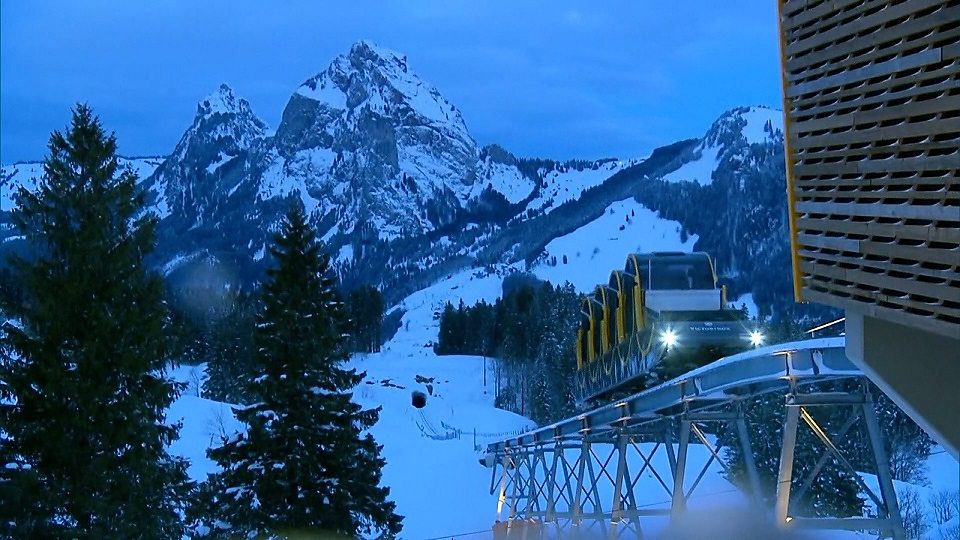World’s steepest railway line 世界上最陡峭的缆索铁路
学习要点
有关“heights 高度”的词汇
边看边答
What dangers did the workers have to deal with on this project?
文字稿
Up here, 13 hundred metres above sea level, is not a view for the faint-hearted, and transporting people up this steep Swiss mountainside is not without its challenges.
Two years behind schedule, it's taken 14 years of building with a price tag of 53 million dollars.
But the Swiss are convinced the new funicular on the world's steepest line is worth it.
Reinhold Boiger, Engineer
“To construct a tunnel with a 110% gradient has rarely been done before. All the workers have to secure themselves. Sometimes they have to work hanging in the ropes. We have to be very careful with the material. If you drop something it falls all the way down, and what’s even more dangerous - if you drop something, it can fall on the head of a worker further below.”
If the breathtaking climb itself doesn't leave you weak at the knees, then standing upright in the carriages shouldn't be a problem either.
They’ve been uniquely designed to allow the floors to adjust with the gradient as it travels.
Each of the carriages can carry 34 people, at a speed of ten metres per second, meaning the climb or descent lasts no longer than four minutes.
The line replaces an old funicular that had been operating between the valley town of Schwyz to the mountain village of Stoos since 1933.
The new space-age looking carriages have been hailed an engineering success. It remains to be seen whether it will help take the area's tourism to new heights.
这里的海拔高度是1300米,眼前的这片风景让胆小的人望而却步,而且要把人运送到这么陡峭的瑞士山峰上来的确充满了挑战 。
比预期完工的时间晚了两年,修筑这条铁路耗时14年,花费5300万美元。
但瑞士人相信这条新建的世界上最陡峭的缆索铁路是值得的。
莱因霍尔德·波杰尔,工程师
“建造一条坡度为110度的地道是我们在过去难得一见的。建筑工人都必须保护好自己,有时他们得悬挂在绳索上作业。我们必须特别小心地处理这些建材,一旦掉了什么东西,它就会一直坠落至山底,而且更危险的是,坠落物很可能会砸到正在下方作业的工人的头。”
如果列车沿缆索惊人的攀升都不会让你害怕得腿发软,那么直立地站在车厢里也应该不会是个问题。
车厢经过巧妙独特的设计,在运行时车厢底部会随着坡度的变化进行调整。
每个车厢可以承载34人,列车的运行速度为每秒10米,这意味着不论是上山还是下山,单程运行时间都不会超过四分钟。
这条线路取代了一条旧的缆索铁路,就是那条从1933年开始运行在河谷小镇施维茨到施图斯山村之间的铁路。
这些看上去充满太空时代感的车厢,被人们称赞为是一次工程设计上的胜利。该工程是否有助于将这个地区的旅游业推向新的高度,我们拭目以待。
词汇
faint-hearted
胆怯的
steep
陡的,陡峭的
gradient
坡度
weak at the knees
(因害怕而)腿发软的
descent
下降,下落
你知道吗?
The name ‘funicular’ is derived from the Latin word funis, which translates as ‘rope’. Funiculars use ropes or chains and operate on a counterbalancing system. The weight of the one at the top pulls against the one at the bottom, making it move.
英语单词“缆索铁道”源自拉丁语中的“funis”,也就是“缆绳、绳索”的意思。缆索铁道依靠缆绳或锁链来达到一种平衡系统,处于高处的缆绳利用重量拉拽处于低处的缆绳,由此缆索机制得以运行。
问题答案
They had to secure themselves and sometimes work hanging in the ropes. They also had to be careful with material. If it dropped, it could have injured a worker below.


 3342次下载
点击下载
3342次下载
点击下载
 2621次下载 点击下载
2621次下载 点击下载
 4734次下载 点击下载
4734次下载 点击下载
 1854次下载 点击下载
1854次下载 点击下载
 1391次下载 点击下载
1391次下载 点击下载
 1391次下载 点击下载
1391次下载 点击下载











